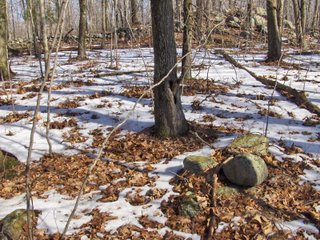 I was walking up a long slope and coming to a more level shoulder with a small knoll or outcrop when I saw a solitary rock pile (shown above). Since isolated rock piles are rare, I thought maybe this one was meant to be viewed from above on the nearby knoll and that, if I went up there I might see some other rock piles - assuming this was organized as a collection of rock piles visible from a high point. Here is a closeup of the outcrop. Note the little bit of stone wall up there.
I was walking up a long slope and coming to a more level shoulder with a small knoll or outcrop when I saw a solitary rock pile (shown above). Since isolated rock piles are rare, I thought maybe this one was meant to be viewed from above on the nearby knoll and that, if I went up there I might see some other rock piles - assuming this was organized as a collection of rock piles visible from a high point. Here is a closeup of the outcrop. Note the little bit of stone wall up there. As I climbed to the top, I was already scanning the slope beyond it and thought I saw one pile and maybe a second one. When I went down to look there were actually lots of piles (~10) hiding in the dead leaves. Here are two examples:
As I climbed to the top, I was already scanning the slope beyond it and thought I saw one pile and maybe a second one. When I went down to look there were actually lots of piles (~10) hiding in the dead leaves. Here are two examples: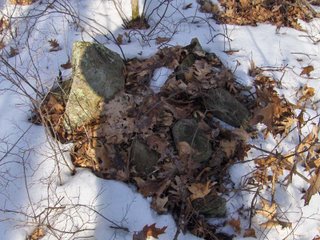
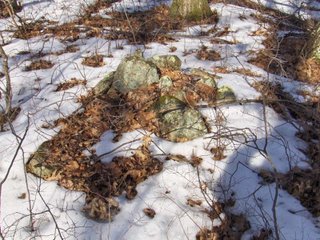 Note the larger pointed rock in the same relative position in the pile in each of these pictures. I call this type of pile "marker piles with a pointer" - the idea being that perhaps the pointed rock marks a location more precisely than the entire pile; and also that the entire pile may serve the purpose of creating a platform for the pointer. [Click here for previous discussion]
Note the larger pointed rock in the same relative position in the pile in each of these pictures. I call this type of pile "marker piles with a pointer" - the idea being that perhaps the pointed rock marks a location more precisely than the entire pile; and also that the entire pile may serve the purpose of creating a platform for the pointer. [Click here for previous discussion]As I circled out further and further from the knoll, whenever I found another rock pile I would glance back to see if the knoll was still visible; and it was. In turn, the pile would be visible from the knoll. Then I came to a line of three piles (the picture is high res if you click on it):
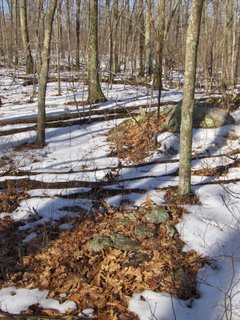 Sure enough when I looked back to the top of the outcrop, it was exactly in line with these piles. Note also the pointer in the middle one.
Sure enough when I looked back to the top of the outcrop, it was exactly in line with these piles. Note also the pointer in the middle one.I continued circling outward. Here is a view back towards the knoll:
 There were walls emanating from the outcrop but not lined up - not that I could see. Rather than enclosing the area of the rock piles, one wall seemed to run down the side of the site and then stop, as if the wall end itself was a feature to be seen from the knoll. I should also mention that this wall along the side of the site was interrupted by a a store ring, possibly a fireplace:
There were walls emanating from the outcrop but not lined up - not that I could see. Rather than enclosing the area of the rock piles, one wall seemed to run down the side of the site and then stop, as if the wall end itself was a feature to be seen from the knoll. I should also mention that this wall along the side of the site was interrupted by a a store ring, possibly a fireplace: All and all I would not expect a normal fire circle in a place like this. I am not sure I saw any signs of charring, but I did not look too hard.
All and all I would not expect a normal fire circle in a place like this. I am not sure I saw any signs of charring, but I did not look too hard.Further down hill, beyond the wall end, the features continued. But rather than being normal rock piles they were made of larger fragments and were overall larger. I kept looking back about 100 yards to see the knoll and thinking "of course the piles are getting bigger - they need to still be visible this much farther away"
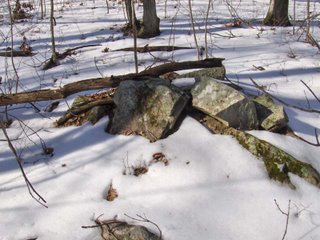 I continued outward a bit further and then circled around to the west a bit and over towards another little highpoint - a second knoll. It was getting so every rock that pocked above the snow was getting a suspicious look from me. And as I came up to this other little high point, I saw a rock-on-rock, then a pile or two and then larger piles over on the downslope a few feet beyond (see video which remains to be posted).
I continued outward a bit further and then circled around to the west a bit and over towards another little highpoint - a second knoll. It was getting so every rock that pocked above the snow was getting a suspicious look from me. And as I came up to this other little high point, I saw a rock-on-rock, then a pile or two and then larger piles over on the downslope a few feet beyond (see video which remains to be posted). These are even more substantial piles than before. They are downslope from another small knoll but I was not sure if they were still visible from the first knoll or rather part of a new organization around the second knoll. One advantage of the "radiating line" hypothesis is that it accommodates the possibility of multiple viewing locations with a second or even more groups of piles on lines radiating outward from other viewing positions. Let's have a look at a couple of these larger piles:
These are even more substantial piles than before. They are downslope from another small knoll but I was not sure if they were still visible from the first knoll or rather part of a new organization around the second knoll. One advantage of the "radiating line" hypothesis is that it accommodates the possibility of multiple viewing locations with a second or even more groups of piles on lines radiating outward from other viewing positions. Let's have a look at a couple of these larger piles: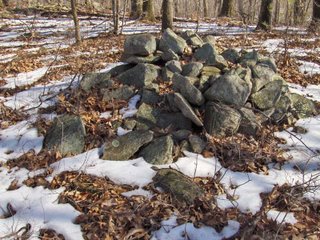
 Please note that this last picture shows a pile with a flat face towards the camera. I find it very interesting that this flat part is facing away from both the near and the far knolls. Either it is to be viewed from somewhere else or this tells us a first clue about these flat faced piles (click here for earlier discussion of flat faced piles).
Please note that this last picture shows a pile with a flat face towards the camera. I find it very interesting that this flat part is facing away from both the near and the far knolls. Either it is to be viewed from somewhere else or this tells us a first clue about these flat faced piles (click here for earlier discussion of flat faced piles).So I'll leave it at that for now. We had a slight confirmation of the hypothesis of radiating lines from a viewing position above the piles. In this case I was expecting the rock piles before I saw them because I found one pile near a knoll and I supposed this might be a site with radiating lines. It is also very interesting that the majority of piles were to one side of the knoll. It is also very interesting that an example of a flat faced pile appeared to be facing away from the viewing positions. So now we have a couple of research questions to pursue:
- Can a central viewing position be located at some of the other sites I call "marker pile sites"?
- In what directions are the lines radiating? Is there any commonality between different such sites as to the directions used? If so, what is the meaning of that direction?
- If we determine a high point viewing position at some of the other sites with flat faced piles, how are the flat faces oriented with respect to the viewing location?
No comments :
Post a Comment